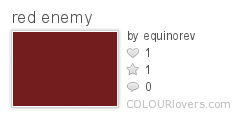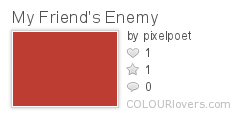Color is one of the most basic visual components of a game, but what are its psychological effects? Activision’s James Portnow looks at all the pretty colors and their psychological effects as it relates to game design.
We’re going to start with the heady and work down to the practical, but this is far from an exact science. I invite you all to share your insights on the subject. Hopefully, with our common pool of knowledge and experience, we can begin to establish a language of color for videogames.
Color psychology breaks down because the symbolic meaning attached to color is almost always the result of cultural acclimatization. Yet it is universally acknowledged that color is one of the most fundamental ways we assimilate information from an image, thus it becomes necessary for us as game designers to create our own form of cultural reference for our players. The move from the primitive intuitive system we use now to something more formalized would allow us to convey greater quantities of information at greater speeds with greater redundancy. As attention spans decrease and the complexity of our games increase, it will be necessary to utilize every tool available to streamline communication.
Color as the Product of Culture

The starkest example of cultural influence on the way we view color is probably the difference between the mourning colors found in many Eastern cultures and those found in Western cultures. In many Eastern cultures, white is considered the color of mourning and is often used to represent death, whereas in the West we tend to use black.
In Islamic cultures, green often has very positive associations, whereas in the United States we tend to associate certain greens with greed. Why? Simply because our money is green.
The one consistent finding of psychological studies on color is that its effects are contextual. Given that that is the case, we can create our own context (i.e. videogames) and then use color to covey meaning within that context.
Preservation of Artistic Expression
Once color begins to be used as a means of communication, one might fear that artistic expression would be compromised. In response I would simply ask you this: do words lose their artistry because they are meant to communicate? Do moving pictures lose their art because we use them to convey meaning?
Rhetoric aside though, I have two points to make on this topic: first, the artistic possibilities of color choice are not reduced by adding the language of metaphor to color, and second, this language will probably be used in very specific and well-understood contexts (for example I don’t think “go” whenever I see green, but I understand the context in which it has that meaning and can intuitively understand when it is being used as such).
What We Know So Far
Ok, so at this point you probably want something practical out of all of this. Let me hit you with this one then: we already have a very primitive color language in games. This may be obvious, but think about red and green.
First, let’s consider red. Think about any game where you can take damage. We usually indicate taking damage by flashing the screen red or placing a red haze in front of the camera. Consider for a moment the last time you first saw such a flash or a haze in a game. You didn’t need to be told what it meant; you knew because you understood that within the context of videogaming red is usually the danger/damage/warning color.
Now imagine if you were to make the flash light blue or green. Somehow that inherently makes no sense to us. We’ve had these associations for so long that we actually feel like taking a different tack is illogical…and it is, because it would be like arbitrarily redefining a word. If I were to tell you that “cat” now refers to a four-wheeled vehicle powered by a combustion engine your mind would recoil and you would reject such a suggestion.
But one can argue that this is true for red because red is the color of blood, or the color of fire, or some other innate and primitive thing. In part this may be true, but let’s look at green. Green is consistently used in games to imply “friendly” or “ally”. This is a use specific to games. One can tie it psychologically to the greenness of nature or culturally to green lights, but the fact still remains that green bounding or a green name in a game almost certainly means one thing: not hostile (1).
1. Brief Anecdote: I recently worked on a game that involved the player attacking targets that were far enough away to be indistinct. The play testers kept complaining about not being able to tell friend from foe. So, without changing any of the instructions we gave to the play testers, we added a faint green glow to friendly targets. Without exception and without asking questions, the play testers had no problem distinguishing from then on.
So Where Do We Use It?
For the most part, using color as a way to communicate meaning will come into play in the broad UI rather than the actual game art itself, though many games have done a brilliant job integrating the two.
For those of you who are interested, I would recommend looking at Elder Scrolls: Oblivion. There they use palette choice not only to drive the mood (i.e. to convey emotional meaning) but also to delineate gamespaces (thereby conveying logical meaning).
Private Language
The greatest danger in developing a system like this is the possibility of developing a private language, a secret cant that only those in the know will understand. We must be wary of sacrificing accessibility for information content. Almost every science does this (law and medicine are excellent examples) but sciences aren’t meant to have mass appeal. We can’t end up developing a new method of conveying meaning only to have it enable us to be more exclusive than before.
This can be avoided though. First we must take our cues from the ordinary and the everyday. We must root our meaning in things which our users encounter on a daily basis (greying out is a good example as that was common in computer UI before it became prevalent in games). Second we can use color to reinforce meaning conveyed in other ways (this has the added benefit of teaching the interactor the “meaning” of the color schema). Third, much in the way film audiences have become accustomed to the language of film simply due to exposure, so too will our audience become accustomed to such a language as games become a societal constant (though this is something we cannot rely on).
Conclusion
As our art form matures we need to develop new tools to use to keep expanding what we can do. Color is only one of many such tools, but it is a powerful one. With any luck this article has at least sparked thoughts on how it can be used and what it means to actively develop such a tool.
Please share your thoughts, experiences and anecdotes. I ask only that you try and reference where you can.
As always, I’m reachable at [email protected].
About the Guest Author, James Portnow
James is a Game Designer for Activision, the lead design columnist for Next-Gen, a COLOURlover and a romantic who still believes that games are capable of making people cry.



